Outsourced IT Support: Is Now the Right Time for Your Business?
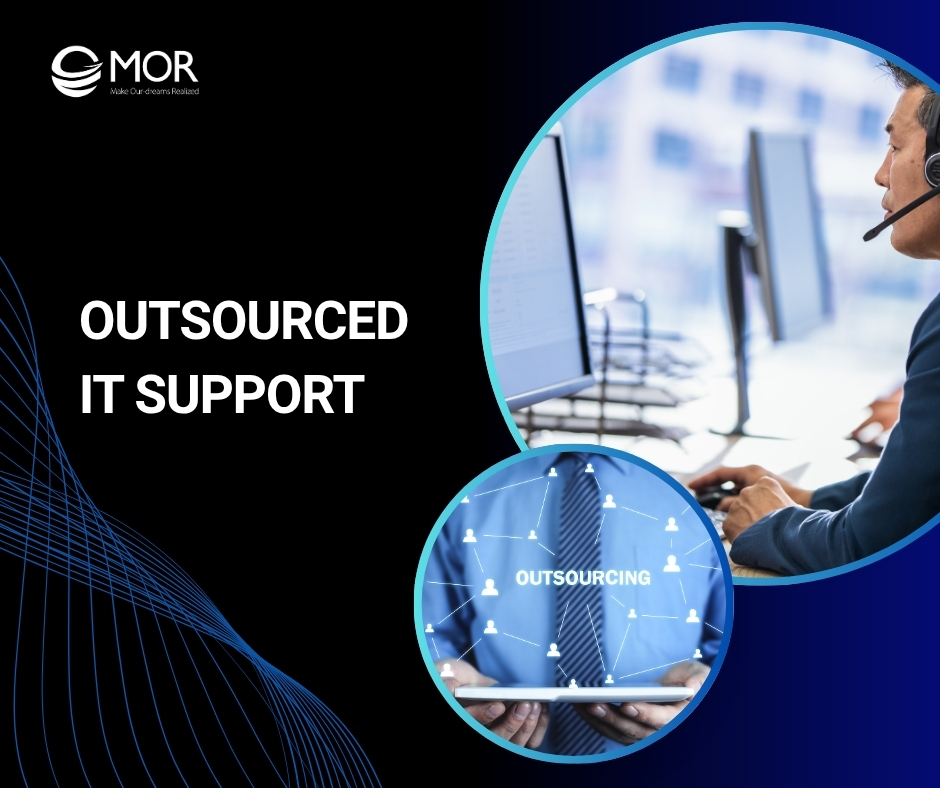
Managing technology in-house is costly, time-consuming, and often limits growth. That’s why more companies are turning to outsourced IT support to gain flexibility, reduce expenses, and strengthen security. This MOR Software’s guide will help you decide if outsourcing your IT operations and partnering with trusted outsourced IT support services is the right move for your business in 2025.
What Is Outsourced IT Support?
Outsourced IT support refers to working with an external partner to manage a company’s technology systems and day-to-day IT operations. Instead of handling every task internally, businesses can rely on experts who specialize in different areas of technology management. These outsourced IT support services vary depending on your goals and internal capacity, allowing flexible control over cost, expertise, and scalability.

Typical areas covered by an IT services outsourcing arrangement include:
- Help desk and troubleshooting for user and system support
- Cybersecurity and compliance monitoring to safeguard business data
- Cloud computing solutions for secure and scalable data access
- Network and infrastructure management, including uptime monitoring
- Software installation, configuration, and long-term maintenance
Partnering with IT professionals ensures smooth, uninterrupted operations while freeing your internal teams to focus on strategic priorities. With reliable outsourced IT support, businesses can maintain strong performance, stay compliant, and adapt faster to new technologies without the overhead of an in-house department.
>>> The cloud cost is often less predictable than it seems, with expenses adding up quickly. Understand the real numbers and manage them with confidence!
Current Trends Shaping IT Outsourcing In 2025
The rise of outsourced IT support continues at a steady pace, driven by global demand for efficiency and specialized expertise. Research shows that more than nine out of ten large companies now rely on IT support outsourcing in some form, with cybersecurity and infrastructure management among the most commonly delegated areas.
The overall market for outsourced technology management is projected to reach $588.38 billion in 2025, growing at a compound annual rate of 6.5%. By 2030, it’s expected to surpass $806 billion, showing how firmly outsourcing has become part of business strategy. This trend reflects how companies prefer flexible, scalable partnerships over expanding costly internal departments.
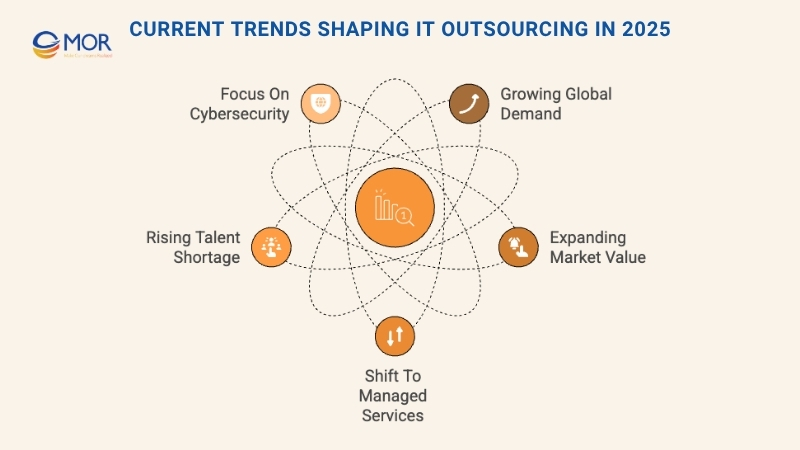
Hiring qualified IT professionals remains a challenge worldwide. Around 42% of businesses cite limited staff availability as one of their biggest obstacles to maintaining reliable systems. That’s why many are turning to IT support outsourcing providers to bridge the talent gap, strengthen security, and maintain continuous performance in a competitive market.
>>> Is offshoring to Vietnam the right decision for your business? What are the outstanding benefits of IT outsourcing?
Main Models Of Outsourced IT Support
Every business has unique goals, budgets, and technical maturity levels, which means not every company needs the same level of external support. When choosing outsourced IT support, organizations can select a model that fits their internal capacity and growth plans. Common options include fully managed, co-managed, and specialized on-demand services, each offering a different balance of control and flexibility through outsource IT support partnerships.
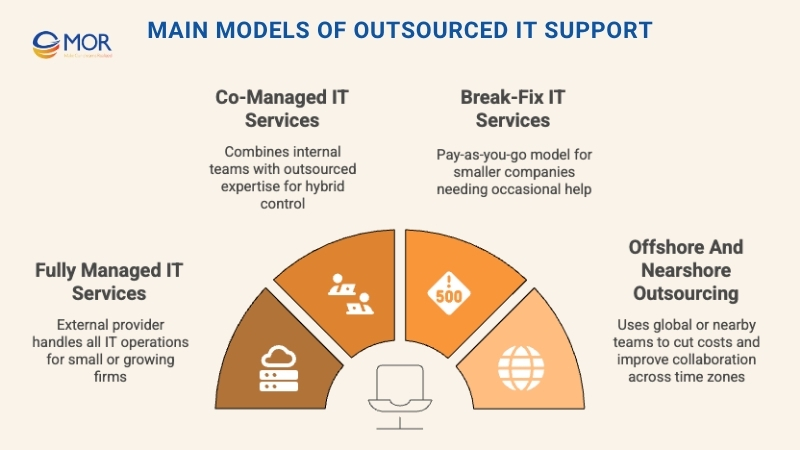
1. Fully Managed IT Services
Best for: Small or mid-sized businesses, startups, or growing companies without an internal IT team.
In this setup, an external provider handles the company’s entire technology environment, from infrastructure and system updates to network monitoring and 24/7 support. The provider also oversees cybersecurity, cloud maintenance, and strategic planning to ensure everything runs smoothly. This hands-off approach is ideal for teams that want complete reliability without the need to build in-house expertise.
2. Co-Managed IT Services
Best for: Medium and large enterprises that already have internal IT departments but need extra help in certain areas. However, do businesses know the benefits of IT outsourcing?
This hybrid model combines internal knowledge with external capabilities from an outsourced IT provider. It allows companies to keep control of critical operations while outsourcing complex or time-consuming tasks such as cloud migration, compliance monitoring, or advanced helpdesk outsource functions. The result is a more collaborative and scalable approach that keeps systems secure, updated, and well-supported.
3. Break-Fix IT Services
Best for: Small businesses with limited technical needs that only require help occasionally.
This traditional approach to outsourced IT support follows a pay-as-you-go model. Companies are billed only when a problem arises, whether it’s fixing hardware failures, software errors, or network downtime. It’s ideal for organizations that don’t need continuous oversight but still want quick and reliable assistance when something stops working. Partnering with an expert for outsource help desk or troubleshooting tasks ensures timely resolutions without long-term contracts.
4. Offshore and Nearshore IT Outsourcing
Best for: Businesses seeking affordable yet reliable IT expertise across borders.
In this model, organizations collaborate with IT support outsourcing companies located abroad to manage operations more cost-effectively. Offshore IT outsourcing means working with teams in distant regions like India or the Philippines, offering lower labor costs but sometimes facing scheduling or communication challenges. Nearshore IT outsourcing, on the other hand, connects businesses with providers in nearby countries that share similar time zones. For example, a US-based company may work with partners in Mexico or Canada to achieve smoother coordination. Both approaches enable businesses to maintain service quality while gaining access to a wider technical talent pool.
What Services Are Included In Outsourced IT Support?
Outsourced IT support covers an extensive range of technology functions and day-to-day processes designed to help businesses operate more efficiently. These services typically include managing networks, servers, and cloud environments, as well as handling system updates, data recovery, and cybersecurity. A trusted partner for outsourcing IT support ensures that every part of your infrastructure stays secure, scalable, and aligned with your company’s goals.

Beyond the basics, many providers expand their capabilities to cover specialized areas like Microsoft 365 administration, end-user support, and IT consulting. Some even go further by integrating EDI, data synchronization, automation, or custom AI solutions to deliver full-spectrum digital transformation. These services give organizations both flexibility and peace of mind that their technology foundation is being proactively maintained and improved.
Most outsourced IT support providers tailor flexible packages to match the business size, structure, and internal skill level. Below are the most common service categories that companies can expect when partnering with a professional provider of outsourcing IT support services.
- Network Management Services: Also known as managed network support, this covers firewalls, routers, and connectivity across devices. Providers offer 24/7/365 monitoring, troubleshooting, capacity planning, and performance optimization to minimize downtime.
- Server Management Services: Continuous monitoring of servers to track uptime, performance, and potential failures. Providers typically manage system updates, virtualization, and specific server operating systems to maintain speed and reliability.
- Cloud Management Services: From setup to maintenance, these services ensure that cloud environments run smoothly. Experienced providers handle scaling, troubleshooting, and cost optimization across hybrid and multi-cloud systems.
- Data Backup and Recovery: Every business needs a strategy for restoring essential data after an unexpected loss. An outsourced IT support partner develops recovery plans to determine whether you should restore data, systems, or both.
- Microsoft 365 Support: Your Microsoft environment needs constant maintenance to stay secure and efficient. An external IT provider oversees synchronization with Active Directory, access permissions, and user account management.
- End-User and Workstation Support: Providers deliver 24/7 technical assistance for staff, covering software errors, system updates, and device configuration. This type of IT support outsource ensures quick responses and minimal downtime for users.
- IT Consulting Services: Strategic planning is essential for growth. Even if you already have IT leadership, an external expert can help evaluate infrastructure gaps, introduce new solutions, and refine your digital strategy.
- Budget and Technology Roadmapping: A reliable IT partner helps you forecast technology costs, build realistic timelines, and plan future upgrades, so you never face unplanned expenses or disruptions.
- Cybersecurity Services: Security is a cornerstone of IT management. Outsourced specialists handle proactive threat monitoring, endpoint protection, and compliance audits to safeguard sensitive business data.
- Client Transparency Tools: Many modern providers include a self-service portal where clients can view real-time data, open tickets, and track progress. This transparency helps companies stay informed and confident in their provider’s performance.
Different organizations have different needs, so the best outsourcing IT support companies take time to understand your business goals before tailoring their services. This ensures you get exactly what your organization needs, without paying for extras that don’t add value.
5 Signs Your Business Needs Outsourced IT Support
Nearly half of organizations worldwide plan to expand their outsourcing strategies this year, showing just how critical outsourced IT support has become for modern operations. If any of these challenges sound familiar, it might be time to explore how professional providers can help.

1. Managing IT Across Offices or Regions Feels Chaotic
When your workforce spans multiple cities or time zones, IT issues don’t stick to business hours. Teams in London, New York, or Sydney may all need assistance at different times, and relying on a limited in-house team makes it difficult to keep up.
Internal staff often get stretched thin supporting different offices, leaving employees waiting for help that never comes. Delays like these hurt productivity and create security risks when systems aren’t updated promptly.
Working with an experienced partner in outsourced IT support, you can establish consistent coverage across all locations. Providers offering outsourcing IT support services deliver 24/7 assistance, centralized knowledge bases, and proactive monitoring, ensuring every employee gets timely, expert help no matter where they are.
2. Your IT Team Is Stuck Handling Small Issues
Your in-house specialists were meant to focus on growth projects, not spend hours fixing login errors or printer malfunctions. Yet, day after day, they’re tied up with repetitive requests that prevent them from addressing critical initiatives like cloud migration, automation, or cybersecurity improvements.
When a team stays in constant “break-fix” mode, long-term goals fall behind, and innovation stalls. Partnering with an experienced provider for outsourcing IT support changes that dynamic. It allows your internal staff to shift from firefighting to forward-thinking, while an external team manages daily operations, maintenance, and helpdesk outsource tasks. This balance frees your experts to concentrate on strategic work that moves the business ahead.
3. In-House IT Costs Keep Rising
Hiring and maintaining a full internal IT department can drain budgets fast. An entry-level technician alone can cost more than $51,000 annually, and that’s before accounting for benefits, software licenses, or ongoing training. Add in hardware replacements, upgrades, and unexpected repairs, and the total investment becomes difficult to control.
Switching to outsourced IT support provides a more predictable and scalable alternative. With a professional partner handling daily operations, your company can replace fluctuating expenses with a consistent monthly plan. This approach helps manage costs efficiently while freeing funds for innovation and growth.
4. Struggles With Security and Compliance
Operating across several countries or regions brings added complexity to IT compliance and cybersecurity. Regulations like GDPR or HIPAA vary widely, and cyberattacks continue to rise each year, making it difficult for internal teams to stay ahead. Without centralized control, maintaining consistent protection and meeting regulatory requirements becomes a full-time challenge.
Shadow IT often makes matters worse, as employees use unauthorized apps or devices without oversight, creating new entry points for threats. A trusted partner for outsourced IT support can help close those gaps. Providers specializing in outsource IT support use advanced monitoring, encryption, and endpoint protection across every connected device. They ensure compliance standards are met, data remains protected, and your organization stays secure in every jurisdiction.
5. IT Systems Limit Scalability
Growth often reveals how outdated systems can slow progress. Each new hire needs proper setup, from hardware procurement to access management and cybersecurity configurations, and when your IT team can’t keep up, productivity takes a hit.
A reliable outsourced IT support partner removes those limits by providing scalable services that grow with your business. Whether you’re onboarding a handful of new employees or expanding into new markets, an experienced IT services outsource team can handle provisioning, support, and maintenance without delays. This flexibility ensures your technology keeps pace with your goals, helping your business expand confidently and efficiently.
>>> Do you know quality team roles and responsibilities, also known as the qa department or quality team, is a decisive factor in a software product's success? Let's explore!
Key Benefits Of Outsourced IT Support
Choosing outsourced IT support can reshape how your business manages technology, helping reduce costs, strengthen operations, and boost overall efficiency. Partnering with the right provider brings a range of measurable advantages that go beyond simple maintenance or troubleshooting.

Cost Control and Predictability
Rising operational costs often strain company budgets, especially when it comes to maintaining internal teams and replacing hardware. A well-structured partnership for benefits of outsourcing IT support introduces financial consistency by consolidating variable expenses into one predictable monthly plan.
Through this model, your agreement typically covers everything from system upgrades and contract lifecycle management software to compliance monitoring and emergency recovery. Instead of being caught off guard by sudden repair costs or software renewals, you gain financial clarity and better resource allocation, all while maintaining strong performance and data security.
Access to Experienced Global Talent
Building a full-scale IT department with specialists in every area, from cybersecurity to networking and software development, is costly and time-consuming. When teams operate across several countries, finding professionals with the right mix of technical and regional expertise becomes even harder. Vacancies or turnover can also leave critical gaps that disrupt business continuity.
Partnering with a trusted outsourced IT support provider gives you instant access to a global network of skilled engineers and consultants. These experts bring years of experience in diverse systems, ensuring consistent quality and reliability. Working with an outsourced IT provider also allows you to support users across multiple time zones efficiently, keeping operations connected and productive at all times.
Flexibility and Quick Scalability
One of the biggest advantages of outsourced IT support is how easily it adapts to your business growth. When demand increases, your provider can expand coverage immediately, adding more resources and support staff without disrupting operations. If you scale down temporarily, you can adjust your service plan, recover hardware, and repurpose equipment without unnecessary costs.
This flexible model allows businesses to respond quickly to changing priorities. Whether you’re opening new offices, hiring remote workers, or moving toward a hybrid setup, a reliable partner for IT support outsource ensures your infrastructure scales smoothly, keeping performance steady and end users fully supported.
Stronger Security and Compliance Management
Cyber threats continue to rise, with over 3,000 major data breaches reported in 2024, a 70% jump since 2021. As billions of users were notified their data had been exposed, the shortage of qualified cybersecurity professionals only worsened, leaving nearly 5 million positions unfilled worldwide. For many organizations, this shortage means limited protection and growing exposure to risk.
Partnering with a trusted outsourced IT support provider helps bridge that gap. These teams bring specialized expertise in threat detection, data encryption, and regulatory compliance, ensuring every system meets required standards. Working with leading service desk outsourcing companies gives your business access to proactive monitoring and rapid incident response, keeping sensitive information safe and operations compliant at all times.
Potential Drawbacks Of Outsourced IT Support (And How to Avoid Them)
It’s common for business leaders to hesitate before shifting control of their IT operations to an external partner. After all, technology is central to daily performance, and the idea of delegating critical systems can feel risky. Yet, with the right structure in place, outsourced IT support can operate seamlessly while maintaining full accountability and transparency.
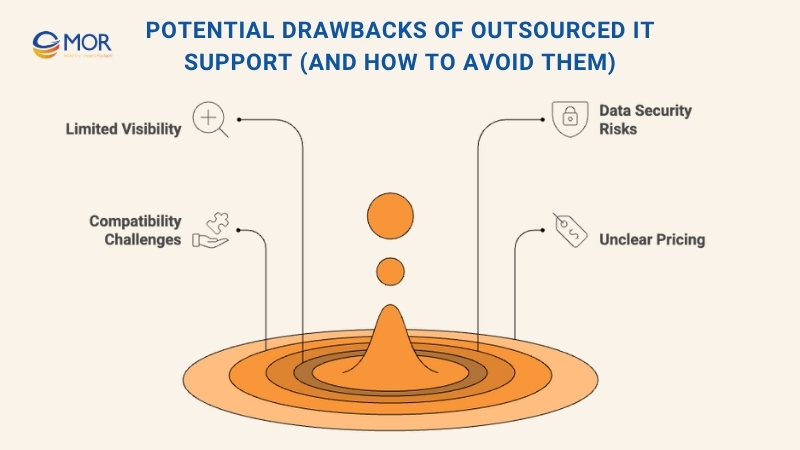
Limited Visibility or Control
When you outsource IT support, you’re entrusting key systems to a remote team, which may raise concerns about slower response times or reduced oversight. Some decision-makers fear losing control of daily activities or not having enough insight into what’s being done behind the scenes.
The best way to address this is through a well-defined service level agreement (SLA). It should clearly specify response times, escalation procedures, and reporting standards. Reliable partners in IT support outsource also provide performance dashboards, regular progress reviews, and open communication channels so you always stay informed and confident about your IT operations.
Data Security and Privacy Risks
Entrusting sensitive company information to an outside provider naturally raises concerns about access control and data safety. Business leaders often ask who can view their data, how it’s stored, and what happens during system transfers or migrations. Without proper safeguards, these moments can expose valuable information to potential breaches.
The solution lies in choosing a reputable outsourced IT support partner that follows strict compliance frameworks such as SOC 2 and GDPR. Leading providers of outsourcing IT support services implement encryption, endpoint tracking, and secure authentication across all devices. They maintain full visibility from onboarding to offboarding, ensuring every piece of data remains protected throughout its entire lifecycle.
Compatibility With Existing Systems
When a business already has an established IT setup, integrating an external team can seem complicated. You may question whether new tools will align with your current software, cloud infrastructure, or workflow management systems. Without proper coordination, overlapping processes or system conflicts could slow operations instead of improving them.
A skilled outsourced IT support partner understands how to work within your environment rather than replace it. Providers experienced in outsourcing IT support focus on seamless integration, connecting with your existing platforms, whether cloud-based, on-premises, or hybrid, so everything functions smoothly. The result is a unified ecosystem that enhances performance without disrupting familiar tools or daily operations.
Unclear Pricing Terms
One concern many companies face when considering outsourced IT support is the potential for unexpected costs. Some providers include additional fees for upgrades, emergency repairs, or after-hours assistance that weren’t clearly defined in the original agreement. These hidden charges can make budgeting unpredictable and erode trust in the partnership.
To avoid this, always review your service level agreement (SLA) in detail before signing. A trustworthy partner in IT support outsourcing will provide transparent, per-user pricing with clear definitions of what’s included. This ensures you receive consistent, high-quality service at a cost that aligns with your financial plan, without any unpleasant surprises later on.
How To Decide If Outsourced IT Support Fits Your Business
While outsourced IT support can enhance efficiency, strengthen security, and lower costs, it isn’t the right fit for every organization. The key is to evaluate your current setup and long-term goals to determine whether outsourcing IT support services aligns with your business model.
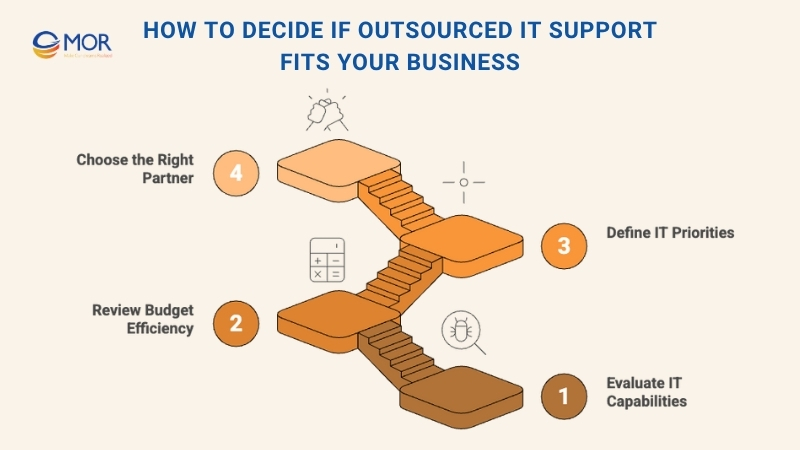
Step 1: Evaluate Your Current IT Capabilities
Start with a realistic assessment of your existing IT resources and skillsets. If your in-house team is limited or constantly juggling daily maintenance, outsourcing can bridge those gaps and provide immediate access to expertise without expanding headcount.
Ask yourself:
- Does your internal team have the capacity to manage all aspects of IT operations effectively?
- Are your specialists focused on strategic improvements, or are they stuck resolving daily technical issues?
- Do you have the infrastructure to manage and support a distributed or remote workforce efficiently?
If these challenges sound familiar, outsourced IT support may be the smarter way to scale your capabilities while maintaining focus on core business priorities.
Step 2: Review Your Budget and Cost Efficiency
Cost is one of the biggest factors in deciding whether to outsource IT support. Building and maintaining an internal department involves salaries, benefits, hardware, and software, expenses that can quickly add up. In contrast, outsourcing offers predictable monthly pricing that adjusts as your business expands.
Consider the following:
- How much are you currently investing in IT staff, tools, and training, and is it sustainable?
- Do unplanned repairs or software renewals disrupt your financial forecasts?
- Can your company afford to expand its in-house IT operations as demand grows?
Working with a transparent provider for outsourced IT support helps replace unpredictable spending with consistent, scalable costs that align with your business goals.
Step 3: Define Your IT Priorities
Before committing to outsourced IT support, outline what your business truly needs from a technology partner. A clear understanding of your goals helps you find a provider that matches your expectations in both capability and coverage.
Ask yourself:
- Are you looking for basic assistance like troubleshooting and ticket resolution, or full-scale infrastructure management?
- Does your industry demand strict compliance, advanced security, or specialized support for regulated environments?
- Do you require 24/7 coverage to maintain productivity across remote or global teams?
When identifying these priorities early, you can partner with an outsource customer service for small business provider that aligns with your workflow, delivers dependable expertise, and supports your long-term strategy.
Step 4: Choose the Right Outsourcing Partner
Once you’ve determined that outsourced IT support fits your business, take time to evaluate providers carefully. The right partner will align with your goals, maintain transparency, and adapt to your existing systems without disruption. Use this checklist to guide your decision:
- Global Reach and Compliance Expertise: Choose a provider capable of supporting international operations while meeting regulations such as GDPR, SOC 2, and ISO standards.
- Seamless Integration: The partner should easily connect with your infrastructure, whether cloud-based or on-premises, to maintain continuity and minimize disruption.
- Security and Accountability: Prioritize companies with strong data protection measures, clear service level agreements, and guaranteed response times.
- Proven Experience: Review case studies, testimonials, and industry reputation to ensure you’re working with a team experienced in managing remote teams, scaling operations, and maintaining consistent performance.
Selecting a trusted outsourced IT support partner gives your organization confidence that every system, process, and endpoint is managed securely and efficiently.
How Much Does It Cost To Outsource IT Support?
Many business owners have questions for IT service providers, but the most common one always centers around pricing. Understanding how outsourced IT support is priced can be challenging because costs depend heavily on your organization’s structure, scale, and specific technology needs.
Generally, most companies begin with a standard service package that includes help desk support, remote system monitoring, regular updates, procurement assistance, server management, and essential cybersecurity protection. These core services provide stability and reliability without overcomplicating the setup.
However, some businesses require more advanced solutions. That may include enhanced cybersecurity, cloud hosting and migration, dedicated on-site technicians, or other specialized technical services tailored to complex environments.
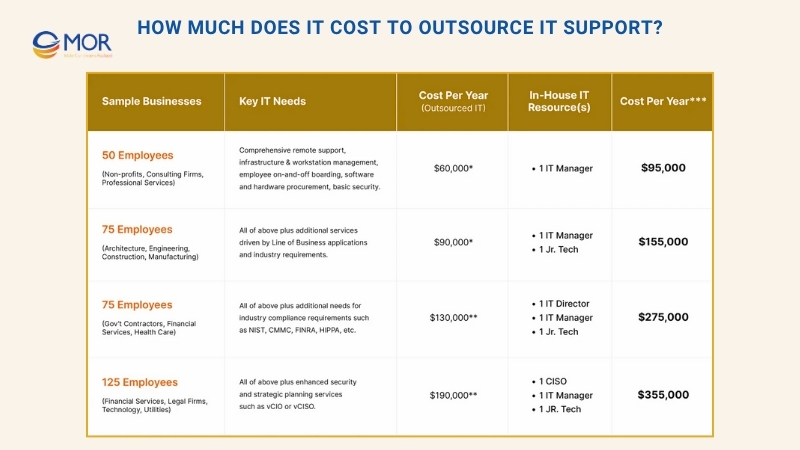
As a benchmark, many providers charge between $85 and $150 per user per month, depending on the service tier and organization size. For instance, a 50-employee company without on-site servers could expect to pay roughly $60,000 per year at an average of $100 per user. This structure allows predictable monthly expenses and eliminates many hidden operational costs.
Occasionally, there may be one-time charges for emergency support visits or strategic consulting sessions. Even so, the overall savings compared to maintaining an in-house IT team, especially one facing overwork or burnout, are significant. Once outsourcing begins, future cost increases typically relate only to additional users or new implementation projects as your business grows.
The total cost of outsourcing IT support varies based on several factors, including organization size, system complexity, and service depth. To illustrate how these differences affect expenses, many providers show simple comparison charts between maintaining internal staff and outsourcing IT operations to a professional partner.
Below is an example using four sample organizations:
- Organization A (50 employees): Basic Plan
- Organization B (75 employees): Basic Plan
- Organization C (75 employees): Advanced Plan
- Organization D (125 employees): Advanced Plan
These figures serve only as general estimates. Each company’s needs, goals, and IT setup are unique, so evaluating your internal costs and growth plans is essential before selecting the right outsourced IT support model for your business.
How To Plan And Budget For Outsourced IT Support Costs
Budgeting for outsourced IT support shouldn’t be complicated when working with a reputable provider. Most trusted partners use a per-user pricing model rather than charging per device, giving you a clear and predictable monthly invoice. This structure is especially useful since most employees use multiple devices for work.

Still, it’s important to stay alert for questionable pricing models that some providers use to disguise extra costs. Watch out for these common tactics:
- Hourly Block Fees: Some low-cost vendors sell a fixed number of hours per month. While this may seem cheaper, once you exceed those hours, they often impose steep overage charges that quickly erase any initial savings.
- Flat Fees: Paying a fixed amount, like $1,000 a month for “unlimited support,” may sound appealing at first. However, this price usually excludes on-site visits, urgent response times, or hardware installations, leading to additional unexpected fees later on.
- Non–Per-User Pricing: A transparent outsourced IT support partner will base pricing on a per-user, per-month model. This format ensures each employee’s needs, storage, technical assistance, and security monitoring, are fully covered. It’s the most reliable way to prevent surprise costs and simplify long-term budgeting.
When you work with a provider offering per-user pricing and a detailed monthly statement, it’s easier to track spending and forecast future expenses. This clarity allows your organization to plan confidently for expansion, technology upgrades, and ongoing improvements without financial guesswork, ensuring your outsourced IT investment remains cost-effective and scalable.
MOR Software: Your Reliable Partner For Global IT Outsourcing
Right now, many businesses are facing uncertainty as AI reshapes the global technology landscape. With markets slowing down and automation disrupting traditional workflows, companies are under pressure to adapt fast or risk falling behind. Some are still figuring out how to integrate AI automation effectively, while others struggle with limited budgets, skills shortages, and growing operational complexity.
At MOR Software, we help organizations overcome these challenges through reliable and scalable outsourced IT support solutions. As a leading software development and IT outsourcing company in Vietnam, we combine technical expertise, business insight, and cost efficiency to help enterprises modernize, automate, and stay competitive in the AI-driven era.
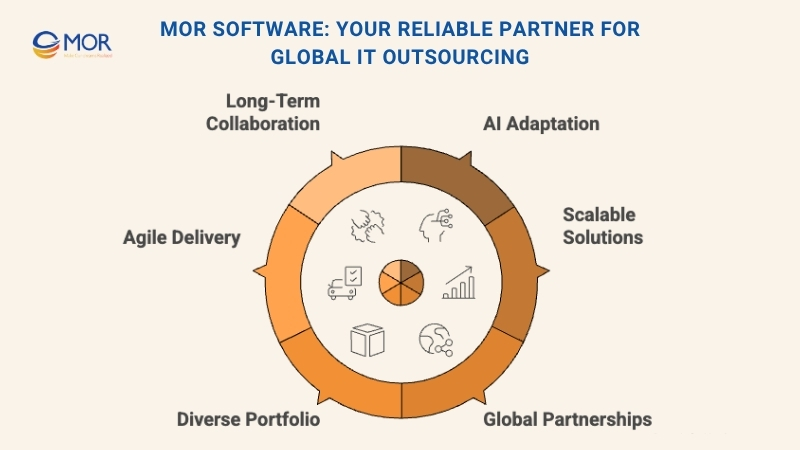
We’ve built long-term partnerships with clients across Japan, the United States, Singapore, and Europe by delivering transparent, outcome-focused collaborations. With over 850 successful projects completed in more than 10 countries, our teams of engineers, analysts, and project managers know how to align technology with real business value.
Our global IT outsourcing services include:
- Custom software outsourcing – End-to-end solutions across web, mobile, and enterprise platforms.
- Salesforce CRM solutions consulting and development – Certified experts for integration, implementation, and release management.
- Cloud and infrastructure management – Secure, scalable cloud setups on AWS, Azure, and Google Cloud.
- AI development service and emerging technologies – Smart automation, data-driven solutions, and innovation-focused products.
- Quality assurance and testing – Comprehensive QA processes ensuring performance and reliability.
What sets MOR Software JSC apart is our Agile delivery, ISO 27001-certified security, and strong commitment to collaboration. We don’t just provide IT services, we extend your team, ensuring every project runs smoothly from planning to post-launch maintenance.
Whether you’re exploring offshore development, AI integration, or complete IT management, MOR Software delivers the people, process, and technology to help your business grow confidently in the new digital era.
Let’s discuss how our global IT outsourcing expertise can accelerate your transformation. Contact MOR Software today.
Conclusion
Choosing outsourced IT support is more than a cost decision, it’s a growth strategy. It gives your business flexibility, scalability, and access to world-class expertise without the burden of managing it all in-house. With MOR Software as your trusted outsourcing partner, you gain a reliable team committed to your success, from daily operations to long-term innovation. Ready to take the next step? Contact MOR Software today to discuss your IT outsourcing goals.
MOR SOFTWARE
Frequently Asked Questions (FAQs)
What is outsourced IT support?
Outsourced IT support means hiring an external service provider to manage your company’s technology operations. This can include network maintenance, cybersecurity, data backup, software updates, and help desk support. The goal is to keep systems running smoothly while freeing your internal team to focus on business growth.
Why should a company use outsourced IT support?
Businesses choose outsourced IT support to lower costs, improve performance, and gain access to a wide range of technical expertise. It eliminates the expense of hiring and training in-house staff, provides 24/7 system monitoring, and ensures consistent, high-quality IT service delivery.
What are the benefits and risks of outsourced IT support?
Benefits:
- Reduced operational and staffing costs.
- Access to specialized IT professionals.
- Scalability and flexibility as your business grows.
- Around-the-clock system monitoring and rapid issue resolution.
Risks:
- Possible data privacy or security challenges.
- Less direct control over IT operations.
- Hidden costs if contracts are not transparent.
What are the main types of outsourced IT support models?
The four major outsourcing types are:
- Onshore outsourcing: Partnering with a provider within your country.
- Nearshore outsourcing: Working with providers in nearby regions for easier communication.
- Offshore outsourcing: Choosing cost-effective teams in distant countries.
- Onsite outsourcing: External professionals working directly at your location.
What IT services are most often outsourced?
Businesses commonly outsource:
- Help desk and technical support.
- Network and infrastructure management.
- Cloud hosting and administration.
- Data backup and disaster recovery.
- Cybersecurity management.
- Software and web development.
- IT strategy consulting and maintenance.
How does the outsourced IT support process work?
The process usually includes:
- Assessing your company’s IT requirements.
- Selecting a qualified outsourcing provider.
- Defining service levels, responsibilities, and goals.
- Transitioning systems and data securely.
- Ongoing monitoring, communication, and performance reporting.
Is outsourced IT support cheaper than hiring an in-house team?
Yes. Many companies save between 70% and 85% by switching to outsourced IT support. It removes the costs of recruitment, training, and employee benefits while providing access to premium tools and technologies under a predictable monthly budget.
What kind of businesses benefit from outsourced IT support?
Outsourced IT support fits businesses of any size. Startups use it to access professional-grade IT services at lower costs, while larger organizations rely on it to strengthen internal teams, scale quickly, and maintain round-the-clock global coverage.
How does outsourced IT support improve cybersecurity?
Outsourcing connects you with cybersecurity experts who provide constant threat monitoring, firewall management, and data protection. They also handle compliance with global standards such as GDPR, SOC 2, and ISO 27001, keeping your business safe from breaches and ransomware.
How can I choose the best outsourced IT support provider?
Choose a provider that offers:
- A proven record of reliability and successful client partnerships.
- 24/7 technical coverage and fast response times.
- Transparent SLAs and detailed reporting.
- Certified cybersecurity and compliance practices.
- Flexible packages that scale with your business needs.
Rate this article
0
over 5.0 based on 0 reviews
Your rating on this news:
Name
*Email
*Write your comment
*Send your comment
1